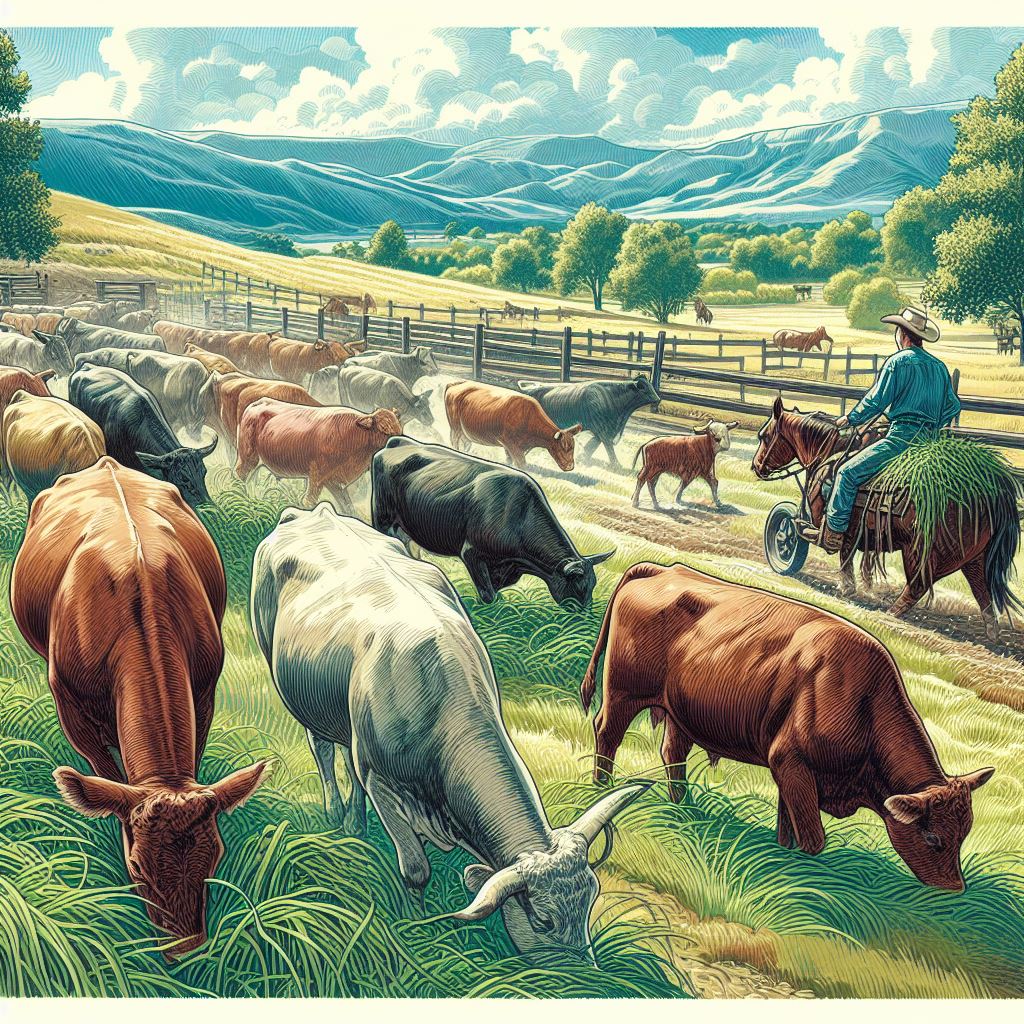
Grazing Management 2.jpg
Rangeland Management
Definition:
Rangeland management encompasses the planning, implementation, and monitoring of strategies to sustainably manage and utilize natural grasslands, shrublands, and savannas for livestock production, wildlife habitat, water conservation, and ecosystem health.
Insightful Analysis:
Rangelands cover vast areas of the Earth’s surface and provide essential ecosystem services, including forage production, carbon sequestration, water filtration, and biodiversity conservation. Effective rangeland management is crucial for balancing the needs of livestock, wildlife, and other stakeholders while maintaining the ecological integrity and resilience of rangeland ecosystems.
Fall off the barn roof and busted your keister? Life on the farm or ranch can be tough on the bum. Need a break? Laugh it off at FarmerCowboy.com, the #1 farm humor site. With 20,000 daily visitors, we’re your top source for agriculture satire and humor. Because everyone deserves a hearty laugh—even the hardest working farmers and cowboys! Join us and turn those long days into fun tales at FarmerCowboy.com.
Guidance for Application:
1. Ecological Assessment and Monitoring: Conducting ecological assessments and monitoring programs is essential for understanding the condition, trends, and dynamics of rangeland ecosystems. This may involve assessing vegetation composition, soil health, hydrological processes, wildlife habitat, and ecosystem services to inform management decisions and prioritize conservation actions.
2. Grazing Management Strategies: Implementing grazing management strategies, such as rotational grazing, rest-rotation grazing, deferred grazing, and targeted grazing, can help optimize livestock distribution, forage utilization, and ecosystem health while minimizing the risk of overgrazing, soil erosion, and habitat degradation.
3. Range Improvement Practices: Implementing range improvement practices, such as reseeding, brush control, prescribed burning, riparian restoration, and water development, can enhance rangeland productivity, biodiversity, and resilience by restoring degraded areas, reducing invasive species, and improving habitat quality for wildlife and livestock.
4. Water Resource Management: Managing water resources is critical for sustaining rangeland ecosystems and supporting livestock and wildlife populations. This may involve implementing water conservation measures, such as riparian buffers, livestock exclusion fencing, water catchment systems, and rotational water access, to optimize water use efficiency and maintain ecosystem function.
5. Livestock-Wildlife Interactions: Balancing the needs of livestock and wildlife is essential for maintaining biodiversity, ecosystem services, and ecological resilience in rangeland ecosystems. This may involve implementing grazing strategies and habitat management practices that accommodate the needs of both domestic and wild herbivores while minimizing competition and conflict over forage resources.
6. Collaborative Management Approaches: Engaging stakeholders, including ranchers, landowners, government agencies, tribal nations, conservation organizations, and recreational users, in collaborative management approaches can facilitate consensus-building, shared decision-making, and collective action to address complex rangeland management challenges and achieve common conservation goals.
7. Adaptive Management and Resilience: Adopting adaptive management principles and practices allows rangeland managers to respond flexibly to changing environmental conditions, market dynamics, and social priorities while promoting ecological resilience, innovation, and learning. This may involve setting clear management objectives, monitoring key indicators, experimenting with different management strategies, and adjusting management actions based on feedback and experience.
Practical Recommendations for Land Managers:
- Develop holistic rangeland management plans that integrate ecological, economic, and social objectives to sustainably manage and conserve rangeland resources for current and future generations.
- Collaborate with interdisciplinary teams, including ecologists, range scientists, hydrologists, economists, sociologists, and indigenous knowledge holders, to develop science-based management strategies that incorporate traditional knowledge, best practices, and emerging technologies.
- Invest in capacity building, training, and education programs to empower land managers, ranchers, and indigenous communities with the knowledge, skills, and tools needed to implement effective rangeland management practices and adapt to changing environmental and socioeconomic conditions.
- Foster partnerships and networks among stakeholders to facilitate knowledge exchange, collaborative research, and community-based conservation initiatives that promote sustainable rangeland management, strengthen local economies, and enhance social cohesion and resilience.
In summary, rangeland management is a complex and dynamic endeavor that requires collaboration, innovation, and adaptive management to sustainably balance the needs of people, livestock, wildlife, and ecosystems. By applying ecological principles, scientific knowledge, and stakeholder engagement, land managers can conserve and enhance the ecological integrity, productivity, and resilience of rangeland ecosystems while supporting livelihoods, cultural values, and biodiversity conservation objectives.
References:
- Briske, D. D. (2017). Rangeland Systems: Processes, Management, and Challenges (2nd ed.). Springer.
- Holechek, J. L., Pieper, R. D., & Herbel, C. H. (2018). Range Management: Principles and Practices (7th ed.). Pearson.
- Sayre, N. F., McAllister, R. R. J., Bestelmeyer, B. T., & Moritz, M. A. (2013). Earth Stewardship of Rangelands: Coping with Ecological, Economic, and Political Marginalization. Frontiers in Ecology and the Environment, 11(7), 348-354. Link
Originally posted 2006-07-15 09:05:53.
Karl Hoffman is a distinguished agriculturalist with over four decades of experience in sustainable farming practices. He holds a Ph.D. in Agronomy from Cornell University and has made significant contributions as a professor at Iowa State University. Hoffman’s groundbreaking research on integrated pest management and soil health has revolutionized modern agriculture. As a respected farm journalist, his column “Field Notes with Karl Hoffman” and his blog “The Modern Farmer” provide insightful, practical advice to a global audience. Hoffman’s work with the USDA and the United Nations FAO has enhanced food security worldwide. His awards include the USDA’s Distinguished Service Award and the World Food Prize, reflecting his profound impact on agriculture and sustainability.

